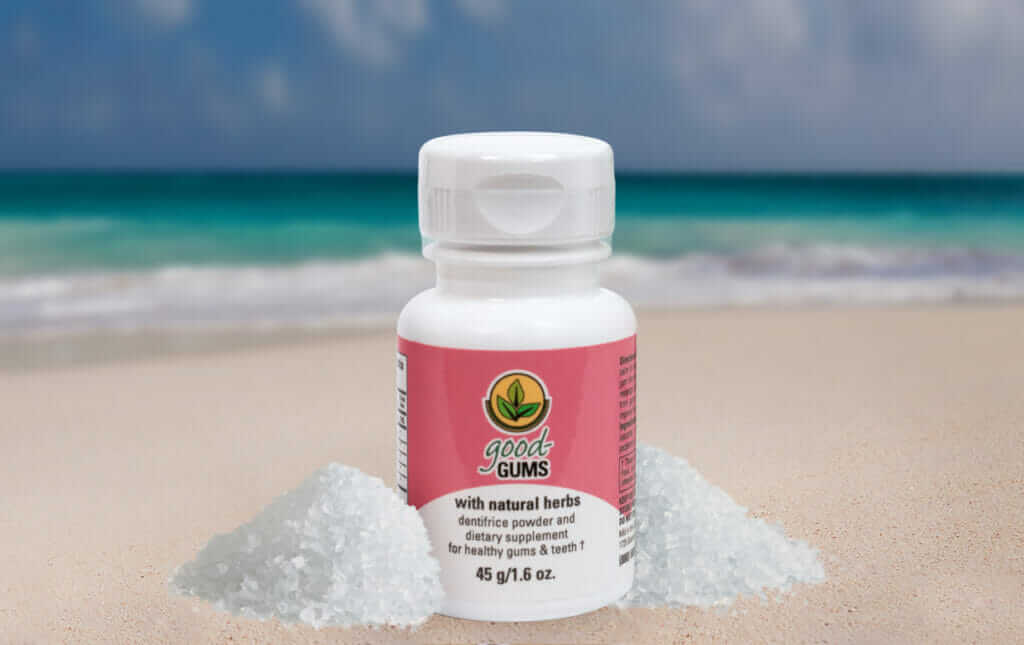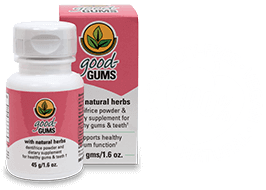Do you feel a slimy, ‘fuzzy’ or rough sensation around the insides of your teeth and around the gum line? Do you feel uninspired by the idea of visiting your dental hygienist for a teeth cleaning? Do you feel annoyed by this rather irritating sensation in your mouth?
We all know that feeling! Most of us, at some point in our lives, have dealt with plaque or tartar, usually when we’ve been a little bit lazy with our oral health, which, let’s face it, it happens! It takes as little as 24 hours for plaque to form into hard calcified tartar, so those unpleasant sensations in the mouth are bound to sneak up on us sooner or later.
Don’t worry! Good-Gums is here to help!
The scientifically backed ingredients in Good-Gums are specifically designed to support your body’s healing itself naturally. After using Good-Gums, you’ll have greatly reduced plaque and tartar formation, your teeth will feel cleaner after each use with no scummy feeling, and your dental appointments will be quicker and easier. Hooray!
Andrea MAmazing product!!! I’m 67 years of age and have had periodontal disease all my life. I have only used this product for seven days and I see a HUGE difference in my gums and decreased plaque and have a wonderful clean feeling in my mouth. So grateful for a product that truly works!*

What does it mean to have plaque and tartar?
Dental plaque is central player in oral health problems that range from gingivitis to periodontal disease to dental caries (cavities). It’s a type of biofilm that’s formed by bacteria that are naturally-occurring in the mouth. As individual, free-floating (planktonic) bacteria, they are quite harmless, as are the other 200 or so strains of oral bacteria that live in the mouth, mostly to help digestion and to ward off outside pathogenic bacteria. But when the plaque-forming strains of bacteria get organized, they cause problems.
Here’s how they get going: Teeth naturally acquire a soft layer of saliva-protein (dental pellicle) within seconds after chewing or cleaning, which helps protect tooth enamel from acids in food. Over several hours, planktonic bacteria float against dental pellicle and loosely attach to it, and then multiply and form micro-colonies of bacteria. The micro-colonies secrete a slimy layer that protects the bacteria, and that also captures yeasts and other organic materials to form a soft transparent biofilm mat known as of plaque. As the plaque develops and expands, the biofilm prevents oxygen from penetrating, and then anaerobic bacteria (that can thrive only in the absence of oxygen) colonize and eventually dominate the plaque.
Within a day or so, the plaque starts absorbing minerals from saliva, and the plaque transforms from a soft biofilm into a calcified mineral deposit that’s harder than bone and that’s cemented tightly to teeth, usually at or just below the gum line. The calcified plaque is called tarter (or dental calculus). Tartar is acid-soaked from the ongoing fermentation process of bacterial feeding, and the acid can dissolve tooth enamel and cause lesions in gum tissue, allowing pathways for bacteria to enter and infect both.
For bacteria to thrive, they need to eat, and the bacteria closest to the tooth surface (especially the anaerobic kind) obtain their food by fermenting sucrose, which is found in the food we humans eat. It’s during fermentation that they produce acids. When humans eat a diet of food that rapidly converts to sucrose (such as refined grains or sugars that are in the vast majority of modern foods), the population of plaque-bacteria proliferates. That’s why primitive societies who didn’t eat grains or sugars had little tooth decay or tooth loss (as shown by isolated hunters and gatherers and by skulls dug up by archeologists), while advanced societies are plagued by gum and tooth problems.
People in primitive societies didn’t have to practice oral hygiene to have healthy mouths. We do, and some of us even have a genetic predisposition to greater plaque and tartar formation. Studies are currently underway to identify the genetic markers of people who are more susceptible.
Let’s see how Good-Gums can help!
Lester PI got the very best report from my Dentist – very little plaque. He said, “Boy, that’s remarkable.”*
How our combination of SCIENTIFICALLY BACKED ingredients help:
Good-Gums is specifically formulated for gums with clinically proven ingredients of the highest purity and potency. It works with your body’s natural processes, whose predisposition is to heal and nurture. Good-Gums takes advantage of two facts about your gums: their cells have some of the fastest replacement rates in your body, and they are comprised almost entirely of connective tissue. In most of the body a cell lives for an average of 7 to 10 years before being replaced, while a new gum cell is replaced after only 7 to 14 days. Healthier gum cells can start replacing less-healthy cells quickly, if they are given what they need. What new gum cells need is what all connective tissue cells absolutely rely on for their formation: a large amount of vitamin C. Good-Gums is unique in providing a healthy amount of vitamin C, plus citrus bioflavonoids that help the body utilize the vitamin C. Check the labels: other products (whether pastes. balms or essential oils) just don’t provide it. The Good-Gums formula dissolves right in the mouth to be absorbed directly by the gums, where it’s needed the most.
The Good-Gums formula also contains a lot of alkaline baking soda to buffer the acidity of its vitamin C, thereby protecting your enamel from acid erosion. To keep the alkaline baking soda from reacting with the acidic vitamin C in the bottle, the entire formula is kept in a dry powder state. When the powder meets saliva in your mouth, it becomes a liquid solution that starts getting absorbed by the gums immediately before these two ingredients (alkaline and acidic) could react or could weaken the vitamin C.

Good-Gums is absorbed more easily by the inclusion of French grey sea salt in our formula, which has a mineral balance similar to human-produced fluids (so much so, that it was successfully used in place of blood for transfusions to some wounded sailors in WW-II, when blood wasn’t available). This matching mineral composition avoids an ion imbalance that would otherwise stop absorption through cell membranes. Since more of the Good-Gums solution can be absorbed, it can do its work quicker and better.
Besides supporting the growth of healthier new gum cells, Good-Gums also has herbal ingredients that soothe sore gums. Myrrh and peppermint are famous for their soothing properties. Cinnamon is a potent anti-inflammatory. And salt solutions are so soothing as to be the standard recommendation by dentists after oral surgery. All are carefully-selected ingredients of Good-Gums.
To help control the population of the plaque-producing bacteria, peppermint, myrrh, and cinnamon act as natural antimicrobials. Baking soda, besides buffering the acidity of vitamin C, also makes the oral environment less favorable for the proliferation of acid-loving, plaque-producing bacteria.
To help remove plaque from constant contact with the gum margins (where they can re-infect the gums), Good-Gums employs the extraordinary property of cranberry, which significantly loosens the grip of plaque bacteria on the nanoscale, so that it the plaque bacteria can more easily be removed by the mechanical action of toothbrush bristles and floss.
Your gums can improve by the combination of these three strategies: by our unique active nutritional support for the formation of healthier new gum cells, by soothing sore tissue while your gums are recuperating, and by reducing the excessive numbers of and contact by infectious agents.
Try it and see for yourself…

Healthy teeth and gums – for life!
Good-Gums goes to work straight away. Feel the difference as our unique formula – containing everything your gums need to heal and restore – takes effect.
During the first one or two bottles, you are likely to notice a definite improvement to your gums. They may feel firmer and tighter. If your gums had previously been bleeding at times, they probably will have stopped. Previous sore spots may no longer feel sore… all encouraging signs that you’re on the right path.
But that’s just the start…
Our goal for you is to have fully restored, healthy gum tissue firmly reattached to your teeth, the elimination of deep gum pockets and no inflammation or irritation, soreness, infection or bleeding – ever again.
And as thousands of customers already know – with Good-Gums it’s possible!
That’s why we recommend that you keep up the good work and continue with an oral care routine featuring Good-Gums for life, so your teeth and gums continue to benefit from our combination of effective natural ingredients.
So invest today in healthy teeth and gums for life with Good-Gums.
How to use Good-Gums for plaque and tartar:
APPLYING GOOD-GUMS WITH A TOOTHBRUSH
Our recommended way of applying Good-Gums with a toothbrush loosens plaque and brushes away loosened debris, disrupting plaque that has formed on the outside and inside flat sides of the teeth. But our method also massages the gums at the same time, helping them absorb the herb-and-vitamin formula that supports healthy gum function. Detailed instructions on how to apply Good-Gums most effectively with a toothbrush come with your shipment.
A tooth brush is an essential tool for breaking up plaque on the front (outer) surfaces and also the back (inner) surfaces of teeth. But Good-Gums uses a slightly different technique than brushing with toothpaste. That’s because toothpaste relies on the abrasives in it to grind away plaque, which is somewhat effective at reducing plaque, but which also grinds away molecules from the surface of tooth enamel. But toothpastes fail to provide any direct support to the growth of healthy new gum cells. Good-Gums does support the growth of healthy new gum cells (through its buffered vitamin C), and it’s also effective at removing plaque, but not by any abrasives. Instead Good-gums employs an herbal ingredient that relaxes bacteria’s adhesive grip, so that the toothbrush can more easily remove the plaque.
The Good-Gums technique is to dissolve some Good-gums powder in saliva to form a liquid solution, and then to angle the brush 45-degrees, to slide some of the bristles into the crevice between the gums and the root of a tooth, and then to wiggle the brush head in tiny circles so that the bristles in the crevice move to and fro. This massages the gums for better absorption.
Toothbrushes intended for use with abrasive-laden toothpaste are relatively hard, even when they’re labeled “medium” or “soft; but with Good-Gums we use an “extra-soft” toothbrush. Instead of using a toothbrush to grind abrasive paste into where plaque forms, a toothbrush is used to massage a dissolved solution of Good-Gums into the plaque and into the gums as well; then the brush sweeps away the loosened debris. Electric toothbrushes can be used with Good-Gums; they almost always come with extra soft bristles.
Flossing
Flossing with Good-Gums (if done properly) is a good way to remove plaque from between the teeth, where a toothbrush can’t reach, while also transferring dissolved Good-Gums below the gum line. Proceed very slowly and gently for the first few days, as your gums may be sore and sensitive, or even bleed. Day by day your gums will get a little more resilient. Put a small pinch of Good-Gums in your mouth and swirl it to the first section (e.g., upper left) that you’ll floss. Move the floss between two teeth (do not snap into place). Then position the floss as deeply as you can into the gum line, pull it tightly around one side of the tooth, and scrape from the root toward the crown. Do not use an in-and-out sawing motion. Floss all the way under the gum line, and the dissolved Good-Gums solution will be moved under there as well. Then halfway-wrap the floss around the side of the other tooth and scrape its plaque loose. Remove the floss and move it to the next split between teeth to floss the sides of those two teeth. When one section is done, take another small pinch of Good-Gums and repeat the process.
Interdental brushes
Because gum pockets are an indication of an underlying history of periodontal disease, it’s important to remove as much plaque as possible from the sides of the teeth. A way to remove even more is with an interproximal brush (sometimes called an interdental brush or proxabrush). It’s a small plastic or wire rod with little bristles spiraling around one end of the rod. Put a small pinch of Good-Gums in your mouth, where it will dissolve, swish it to a section of teeth and move the interproximal brush in and out between teeth, using the spiraled bristles to massage the dissolved Good-Gums into the gums. This practice is particularly beneficial for addressing gum tissues that have detached and have formed pockets on the ides of teeth.
Soaking the gums around a troubled spot
A good way to use Good-Gums is to let it sink into the tissues, folds, and crevices of a troubled spot for a longer time than the exposure from the above steps.
• Put a small pinch of Good-Gums into your mouth and let it dissolve.
• Swirl it over any areas of particular concern and hold it to let the liquid cover the problem area.
• Gum tissues do absorb quite readily, so let the Good-Gums stay there for a few minutes.
Supragingival oral irrigation
Oral irrigation is an additional step beyond the toothbrush, floss and interdental brushing. Gum pockets can harbor anaerobic bacteria, which need an airless environment to thrive, and gum pockets provide the necessary airless condition. To help overcome gum pockets, the bacteria should ideally be flushed out regularly. Merely rinsing the mouth (even with Good-Gums) does not provide for much penetration into gum pockets. An oral irrigator will deliver an aqueous solution into periodontal pockets and will penetrate on average to approximately half the depth of the pockets. An oral irrigator has a wand connected to a reservoir with a water pump, such as Hydrofloss, Waterpik or Viajet, that shoots liquid into the gum line and between teeth. Oral irrigators are especially effective for pockets less than 4 mm deep. Put a little Good-Gums in your irrigator’s reservoir to give the water a little boost; rinse the wand with clear water after each use.
Subgingival irrigation
Subgingival irrigation provides a way to flush out gum pockets that are deep, i.e., 5mm or deeper. This is a viable tactic when the measures described above aren’t enough to reduce your gum pockets. A subgingival irrigator is like a regular oral irrigator in that both squirt a liquid solution between the gums and the teeth. A regular oral irrigator uses a nozzle that is held a short distance from the gums and teeth, relying on the water pressure to squirt the liquid into the gum pockets. A subgingival irrigator has a small thin reed-like nozzle with a rounded tip (called a cannula) that is slipped between a tooth and its gums before the liquid is squirted. The pocket is quite effectively flushed out if the tip of a subgingival irrigator is inserted 3 MM (a little less than 1/8 inch) into the pocket. It’s best to use a subgingival irrigator only on very deep pockets, and to know which sides of which teeth have the deep pockets; ask your dentist or dental hygienist for a copy of your “perio chart.” Subgingival tips are available for Hydrofloss irrigators (use the Oral Irrigator Sulcus tips) and for Waterpik (use the Pik Pocket tip) and also for Viajet (use the SulcaSoft tip or the Deep Pocket Irrigation Kit). If you don’t have an oral irrigator machine, you can use a manual subgingival irrigator which is less expensive (such as the Oral Breeze Deep Pocket Irrigator Syringe and Tips or the OraTec Pocket Care Irrigator). Dissolve a little Good-Gums in a regular water glass or bottle before drawing the solution into manual irrigator; rinse it out with clear water after each use.
Joanna PI wanted to write to you about Good Gums, because out of all the organic tooth powders I’ve been using, yours is the first one that really whitened and took the plaque off quickly.The second time I brushed with Good Gums — and only Good Gums — my teeth looked impossibly white and felt incredibly clean. Even the tops of the teeth, near the gums, that are usually yellowish, looked pearly white. I’m really fascinated. It must be the specific blend of ingredients. I will definitely recommend to all my friends!*

How to tell that Good-Gums is working:
A reduction in soft plaque is the obvious sign that diligently practicing your oral hygiene practices with Good-Gums is working. Your tongue won’t feel that fuzzy or slimy sensation that you had been used to, and may have thought was normal. When there’s less or no soft plaque built up, there won’t be the necessary starting point that develops into tartar.
If you’ve had a dental cleaning that has removed the tartar that has previously formed, then you should notice a reduction in the formation of calcified tartar on your teeth at the gum line.
One way to tell if you’ve been effectively removing plaque is by using disclosure tablets or a disclosing solution. One of the earliest indirect indicators is to look for the absence of plaque and tartar; this can be accomplished by using a chewable disclosing tablet or a liquid disclosing solution after your daily routine of brushing, flossing, interdental brushing, and/or oral irrigation. A disclosing solution is available at drugstores and it reveals any remaining plaque or tartar by staining it with vegetable dye, and then the dye can easily be brushed away along with any plaque that was missed. If there is no plaque or tartar, there will be no source of additional infection, and there will be no new occurrences of gum infection, and the underlying cause of most gum recession will be absent.
How long until you can see results:
Many people notice a positive difference from the very first day. Your mouth typically has that “just back from the dentist” feeling, when the removal of soft plaque is so complete. With each passing day of diligent use, you can expect a continuation of that feeling, and, if you’ve had chronic bad breath, a reduction of that, as well.
Thank goodness for Good Gums!!
Want to know more about other common GUM HEALTH ISSUES?



